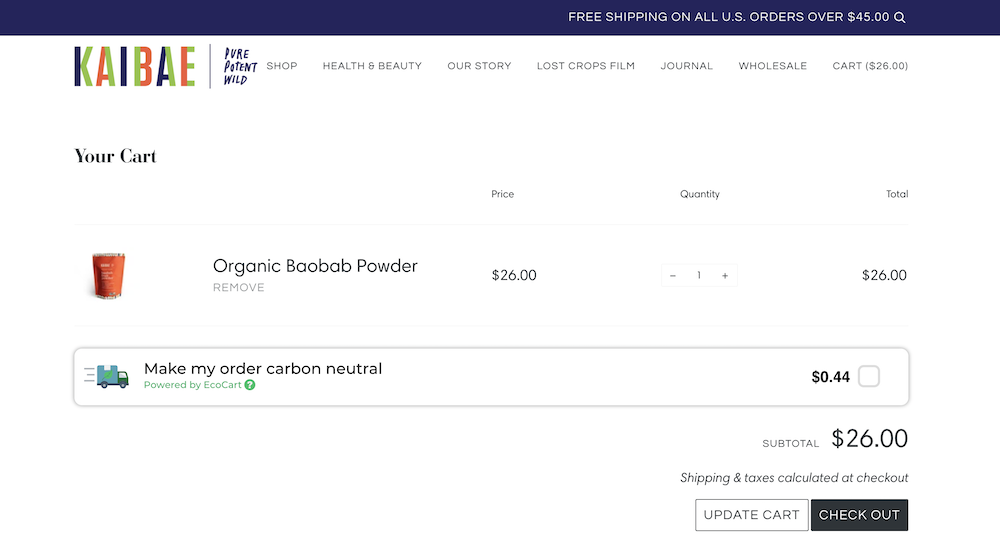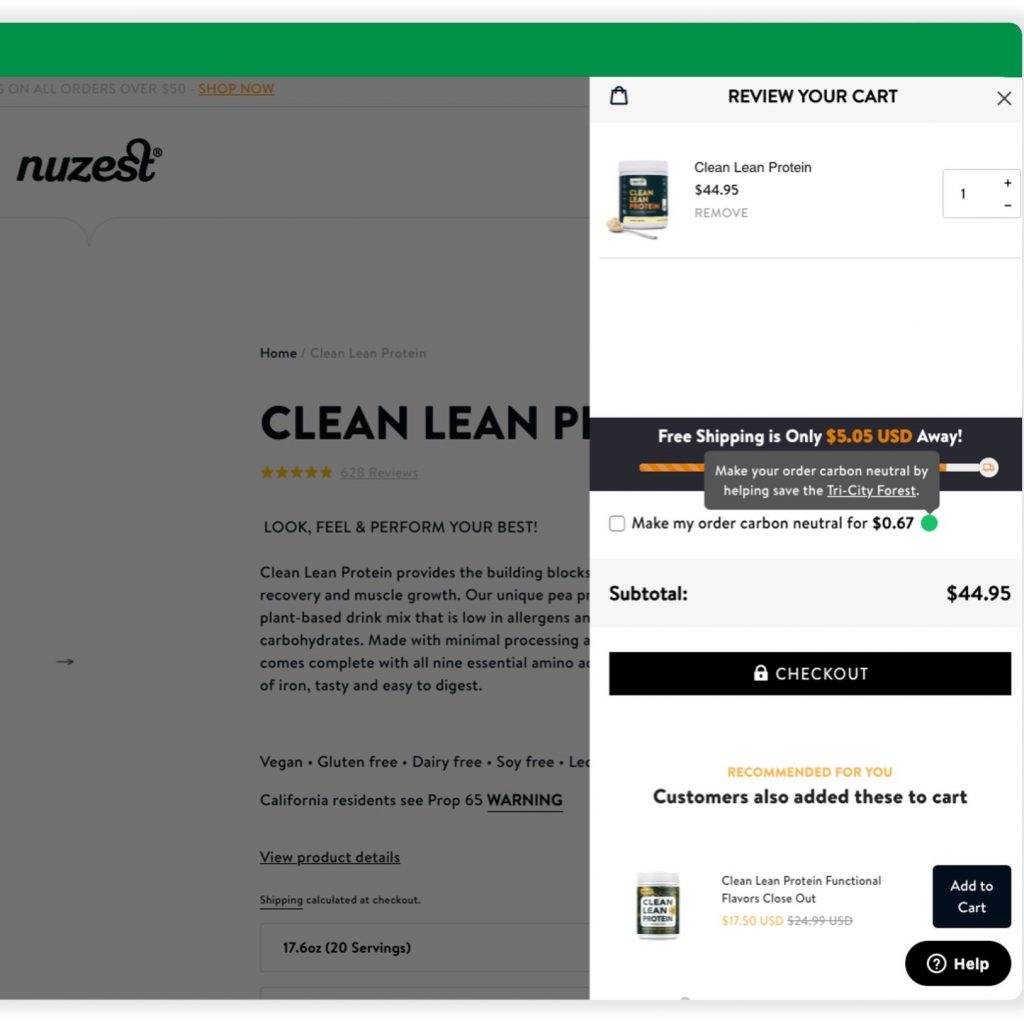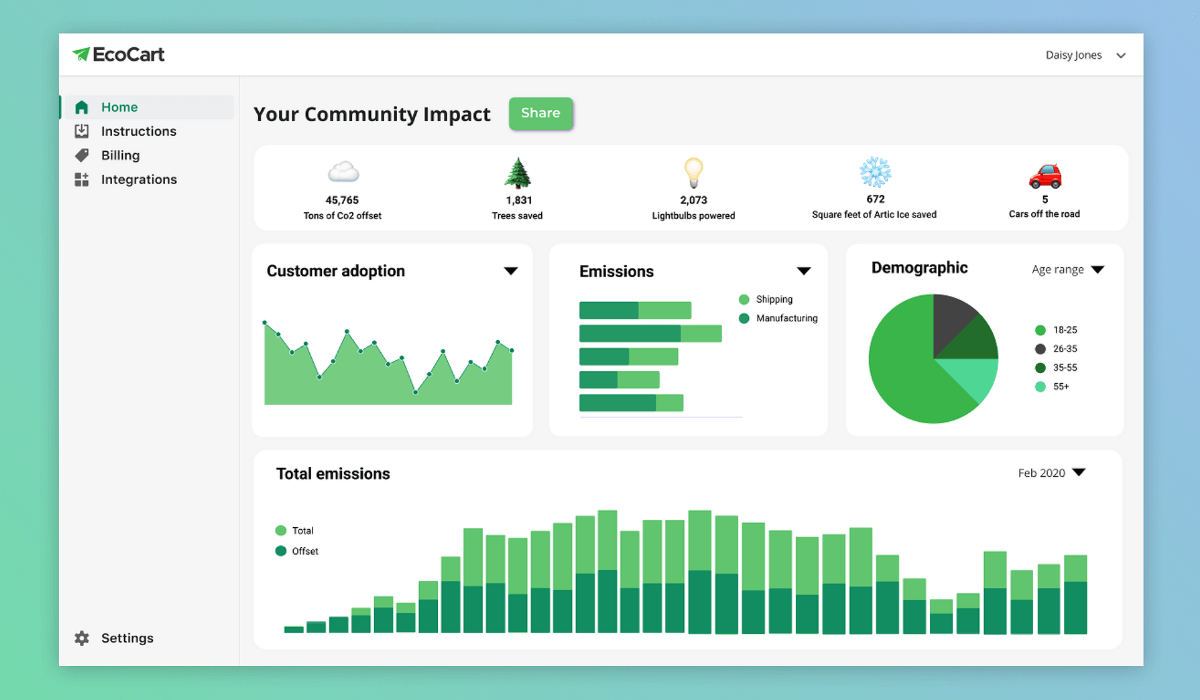Sustainable marketing is more than just a gimmick (AKA greenwashing). It is an opportunity to showcase your sustainability initiatives and connect with eco-conscious consumers.
But, what is sustainable marketing, and how can you implement it effectively? Here’s our guide.
What Is Sustainable Marketing?
Sustainable marketing is when a company promotes and advertises its sustainability programs, such as its efforts to reduce its environmental impact as well as its social responsibility. Sustainable marketing seeks to nurture customer loyalty after they’ve converted a sale. It builds an emotional bond between the customer and the brand by illustrating positive actions that align with the customers’ values.
Ecommerce companies and sustainable brands that take the time to market their environmental and social responsibility are able to tap into the consumers’ call for a positive impact.
Why does sustainable marketing matter?
Today’s consumers expect their favorite brands to be both socially and environmentally responsible. In fact, here’s exactly what consumers want:
- 72% said that companies must be active in the well-being of their employees, and 66% stated that they expected companies to reduce their environmental impact.
- An overwhelming number of young consumers—almost 90% of Gen Zs and millennials—want brands to be operating sustainably.
- 76% of consumers will drop a brand if they don’t demonstrate sustainable business practices.
- 68% of consumers say they’ll be loyal to a brand that shares the same values, like sustainability.
Because sustainability is becoming more of a consumer demand than desire, sustainable marketing strategies are essential to stay relevant. Sustainability marketing allows you to share your sustainable business practices and place your company ahead of its competitors.
Unfortunately, green marketing isn’t straightforward. Telling your sustainability story requires a delicate balance. You must authentically share your sustainability experience without falling victim to greenwashing claims.
Download our FREE ebook:

Sustainable marketing practices in 2023
Online shoppers are paying attention to their favorite brands’ sustainability impact. A study by McKinsey and Nielson IQ found that “products that make environmental, social, and governance-related claims have achieved disproportionate growth.”
On top of this, HubSpot found that 43% of effective marketers address social issues in their campaigns compared to ineffective marketers. This clearly indicates that a sustainable marketing strategy is essential for sustainable business growth.
Paradoxically, consumers don’t want to be marketed to. Modern marketing is about weaving a story, educating consumers, and drawing them into a brand’s values. Here’s exactly how to do that.
5 Eco Friendly Marketing Strategies
Here are some examples of sustainability marketing strategies that your sustainable business might explore.
1. Start with solid sustainable practices
If your brand is truly sustainable, adopting sustainable marketing is much easier. If not, then find out where you can improve first. Invest in an ESG report by a trusted entity, and build your sustainability strategy from there.
To get a quick idea of where your business stands, try our sustainability scorecard quiz:
Once you have an idea of where your business can improve, identify actionable sustainability KPIs to guide your efforts.
When designing your sustainability initiatives, make sure that your approaches are thorough. Pay attention to both the big and the small stuff. For example, sustainable shipping practices can have a massive impact on your emissions. So too can switching to eco-friendly web services, reselling returned items, and using compostable materials in packaging.
2. Align your story with your customers’ values
When developing your sustainability marketing strategy, highlight the areas of your sustainability plan that align with your customers’ values.
If you find that your customers are concerned about climate change, showcase your plan to reduce your business carbon footprint, and educate them on how they can reduce theirs, too. If plastic waste is their primary concern, call attention to your eco-friendly packaging, and encourage your customers to recycle the packaging after they’ve received their shipment.
So how do you know what your customers value? Here are a few ways to find out:
- A simple customer survey asking which sustainability issues are most important to them.
- Customer data showing which sustainable products are most popular.
- Customer support teams engage with your customers directly, so they likely have some insight on what’s concerning your customer base the most.
Customers want to support brands that align with their values, so spotlight the ways that you’re promoting their principles.
3. Seek to educate rather than market directly
Today’s consumers want to be informed, and in order to gain their attention, you need to be their informer. They seek out educational materials such as blog posts, short-form videos, and other forms of content. This is why effective green marketing strategies include telling a sustainability story.
Paint a picture of your sustainability program by walking your audience through your decision-making process and including them in your journey.
Tribe Kelley does this on its About page, sharing the brand’s heartfelt journey toward a sustainable future.
Another easy way to involve your customer base with your sustainable marketing efforts is to illustrate to your customers how purchasing your product helps you achieve your sustainability goals.
Wildway has a page dedicated to educating its customers on their sustainability initiatives, including eco-friendly packaging and carbon neutral shipping.
Face the Future educates its audience about sustainability in the beauty industry and what the brand is doing to be more sustainable.
Whatever the case, find a way to educate your customers on both your brand’s journey and its sustainability initiatives.
4. Invest in eco-friendly packaging and design
Packaging is the greatest contributor to greenhouse gas emissions (GHG) in the ecommerce industry, accounting for 45% of emissions. Remarkably, this is one of the easiest and most solvable issues in ecommerce.
The best part? You don’t even have to market it.
You just send your products to your customers and they will see you putting your money where your mouth is by showing your commitment to sustainability through your packaging.
Face the Future is a great example of a brand that uses eco-friendly packaging as a sustainable marketing tactic. Right on its Sustainability page, the brand explains why it uses recyclable packaging.
If you use minimalistic packaging that’s recycled and recyclable, and your products include circular materials, that can be enough to convince your customers of your commitment to sustainability. Actions are often louder than words when it comes to sustainable marketing.
5. Engage your customers in your sustainability journey
Part of the reason why people seek sustainable brands is that it feels good. By making them a part of your sustainability journey, you can tap into that warm feeling and encourage them to continue to buy your products. Eco-friendly apps like EcoCart make it easy.
With EcoCart, you can allow your customers to opt-in to carbon-neutral shipping with carbon offsetting. That way, they can feel good about their order while you step a little bit closer to your carbon emissions goals.
We also offer resources to help you share your sustainability journey as well as a carbon dashboard that allows you to track and measure your impact.
Learn more about our offerings here.
6 Sustainable Marketing Examples in Ecommerce
Because sustainable marketing can refer to a wide range of strategies and approaches, it’s beneficial to see some campaigns in action. Here are some of our favorite examples of sustainable marketing.
1. Simbly
As a sustainable furniture company, Simbly offers a gorgeous example of a holistic approach to sustainable marketing. You can see its commitment to eco-friendly practices in every aspect of its marketing, from branding to its products. Because sustainability is part of its core values, Simbly’s commitment to social and environmental responsibility can be seen in every facet of its marketing strategy. Customers are left with zero doubt as to its sustainability approaches.

2. Nomad Goods
Nomad Goods, a consumer electronics and lifestyle products company, aimed to minimize its carbon footprint and engage customers in its sustainability mission. To achieve this, they integrated EcoCart into their checkout process, allowing customers to opt for carbon-neutral orders. As a result, over 30% of their customers chose this sustainable option, showcasing both the brand’s commitment to the environment and the positive reception from their consumer base.
3. KAIBAE
KAIBAE is dedicated to delivering high-quality, sustainably sourced products. To further their commitment to the environment, KAIBAE integrated EcoCart into their Shopify store, enabling carbon-neutral shipping options for their customers. As a result, nearly 50% of KAIBAE’s orders have been made carbon neutral, resonating with their eco-conscious customer base and reinforcing their brand’s dedication to sustainability.

4. Patagonia
You don’t have to be a sustainability company to create sustainable marketing campaigns. Patagonia proves this. Interestingly, they’ve adopted an anti-marketing strategy, encouraging shoppers not to buy new clothing, instead wearing out their Patagonia gear or buying used apparel. In 2011, they ran a marketing campaign with the tagline, “Don’t Buy This Jacket.” Although this marketing campaign may seem counterintuitive, it resonated with its target market and cultivated a loyal customer base. They love that Patagonia seems to walk what they talk, and it’s now known for its environmental sustainability.
5. Nuzest
Nuzest, a premium nutritional supplements brand, exemplifies sustainable marketing by integrating the EcoCart carbon offsetting solution into their online checkout process. This allows customers to make their orders carbon neutral with a simple click. By offering this eco-conscious option and promoting it through their marketing channels, Nuzest not only showcases its commitment to the environment but also resonates with a growing segment of eco-aware consumers, enhancing brand loyalty and trust.

6. Juneshine
JuneShine, a San Diego-based alcohol company, emphasizes sustainability in its operations, from using solar energy to being 100% carbon neutral certified. To further engage customers in their eco-mission, they partnered with EcoCart to offer a checkout experience that goes beyond carbon neutrality to being climate positive. Since implementing EcoCart, 43% of their orders have been made carbon-neutral, offsetting over 2.26 million pounds of carbon.

How To Avoid Greenwashing
A major concern within sustainable marketing is greenwashing. Luckily, there are many ways to avoid greenwashing.
The key to avoiding greenwashing is through pursuing effective and science-backed sustainability approaches in an authentic and genuine manner. Essentially, your company must pursue sustainability because it’s the right thing to do. Gaining loyal customers is only a happy side effect.
Here are three ways to ensure that you avoid greenwashing in your sustainable marketing strategy.
- Seek green certifications for business. By having a trusted third party verify your sustainability, you’ll automatically gain the trust of your target audience. Besides this, going through the process of gaining a green certification will ensure that your business is, in fact, sustainable.
- Be transparent. Customers want to trust the brands that they support. Greenwashing claims often arise because they feel as though the wool has been pulled over their eyes. Be clear and transparent about your sustainability goals, and don’t shy away from your missed targets. If you’ve failed to achieve a goal, be upfront about it. Customers will be more forgiving of an honest shortcoming than they will of deception.
- Use numbers and data to show your progress. It’s not enough to tell customers that you’ve reduced your carbon footprint. You need to let them know exactly how much your carbon emissions have lowered.
All three of these can be achieved through a carbon dashboard that tracks and analyzes your carbon footprint in real time. A carbon dashboard provides quantitative data for all aspects of your sustainability goals.

With an app like EcoCart, you can be transparent about your carbon footprint and invite your customers to join you on your fight against climate change.
How To Create Sustainable Branding
Sustainable branding goes beyond just selling products; it’s about building a brand identity rooted in environmental and social responsibility. By prioritizing eco-friendly practices and ethical values, brands not only appeal to conscious consumers but also make a positive impact on the world.
Luckily, the key to sustainable branding is to simply be a sustainable brand.
Following all of the sustainable marketing tips above, here are actionable steps for an ecommerce brand to establish sustainable branding:
- Assess Impact: Evaluate your current environmental and social footprint.
- Source Responsibly: Choose eco-friendly and ethically sourced materials.
- Transparent Communication: Clearly share your sustainability efforts and goals with customers.
- Eco-Friendly Packaging: Opt for recyclable or biodegradable packaging.
- Support Green Initiatives: Partner with or donate to environmental or social causes.
- Educate Consumers: Offer content that informs customers about sustainable choices.
- Continuous Improvement: Regularly review and update sustainability practices based on feedback and new developments.
Conclusion
Sustainable marketing encourages customer loyalty by showcasing your sustainability journey. But, it’s only effective if done the right way. Interested in bringing your sustainable marketing to the next level? Reach out to our team for a demo today.



